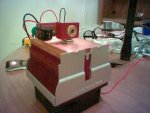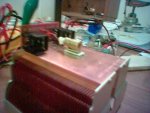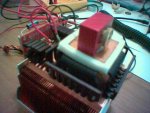Abray said:
how can I protect the diode from being ESD killed?? how exactly could I ground myself so I won't shock the diode?
Well, your question was mainly answered already... Just wear a grounded wrist strap while building. You can make one yourself, if you have elastic band, some velcro, a piece of metal and a wire with an aligator clip..
The reason i was talking about PSU "dangers" was, because i killed two blue rays (and some reds, but probably for other reasons), by powering their drivers from a PSU.. While building i was grounded, but i thought they would be safe in a circuit and with caps directly on their leads..
So when i was aligning the BR beam with a 5mW red beam to compare them, i wasn't grounded anymore.. So i went along the beams to look against them, and they were not properly aligned for a photo i was trying to make, so i went back, touched the AixiZ module the Blue Ray was in, and it suddenly lost 2/3 - 3/4 of it's power..
That's why i don't use a PSU to power laser drivers anymore.. I only use battery power.. A PSU provides a path to the ground for ESD.. A battery doesn't..
Reds are much less sensitive, but on the other hand, maybe people weren't pulling such huge sparks as me, that fatefull day..

But now i don't have to worry about ESD anymore, since it has nowhere to go to, without a ground path... I still touch the radiator before touching anything else, while building, but touching a finished laser isn't dangerous anymore.
I had a big 12V lead battery, and didn't know what to do with it, so i turned it into a safe power supply for my experiments.. This is how i do everything laser related now.






